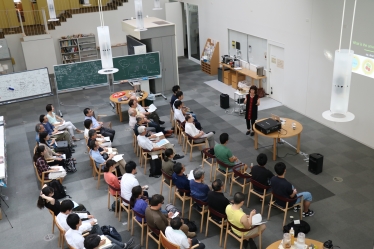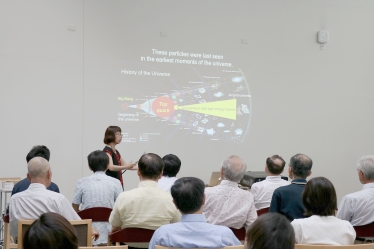Kavli IPMU Science Café: “What Can a Particle Accelerator Discover?” with Young-Kee Kim

Date of activity: July 15, 2017
Surrounded by blackboards covered in equations, on July 15, 2017, members of the public were invited into the heart of an institute dedicated to solving the mysteries of the Universe to learn and discuss ideas with world-renowned experimental particle physicist Young-Kee Kim about how the tiniest particles in existence have shaped our Universe.
The Kavli Institute for the Physics and Mathematics of the Universe hosted the Science Café “What Can a Particle Accelerator Discover?” inside the same building where its researchers work every day.
To begin with, everyone was invited to watch a screening of Particle Fever, a 2013 documentary film following both experimental physicists working to get the much anticipated Large Hadron Collider (LHC) up and running so they can search for the Higgs boson, and the theoretical physicists whose work makes up the foundation of the LHC and who are now eagerly awaiting the results to see how their theories, some decades in the making, match up.
Kim, who spends much of her time at CERN working with the Large Hadron Collider, described the celebrations triggered by the Higgs boson discovery and how it became top news internationally. The significance of the Higgs boson, she said, was that researchers could finally explain why particles have mass, and ultimately why all matter, including humans, exists.
However, the next point Kim made was that the Higgs boson was not the final goal of particle physics, and that almost 30,000 particle accelerators exist in the world today from those at CERN in Europe to KEK/J-PARC in Japan to Fermilab in the United States. Some particle accelerators are made for scientific discovery, some for manufacturing, and some for national security.
Kim explained how particle accelerators today are helping researchers to uncover mysteries of the Universe such as the identity of dark matter, and how they were giant microscopes, allowing researchers to study the particles our Universe is made of. They were also time machines, allowing researchers to study particles from the earliest moments of the Universe.
As an example, Kim described how trillions of neutrinos zip through people every second. Projects being carried out today at J-PARC and Super-Kamiokande in Japan, and Fermilab in the United States are looking for direct evidence of CP violation.
After Kim’s talk, everyone was invited to tea time, and several participants including lots of young students were seen approaching Kim, asking her questions about her talk and exchanging ideas over tea and biscuits.

Science Café in Kavli IPMU (credit: Kavli IPMU) 
Speaker Young-Kee Kim gives a talk about particle physics experiments in particle accelerators today (credit: Kavli IPMU)






